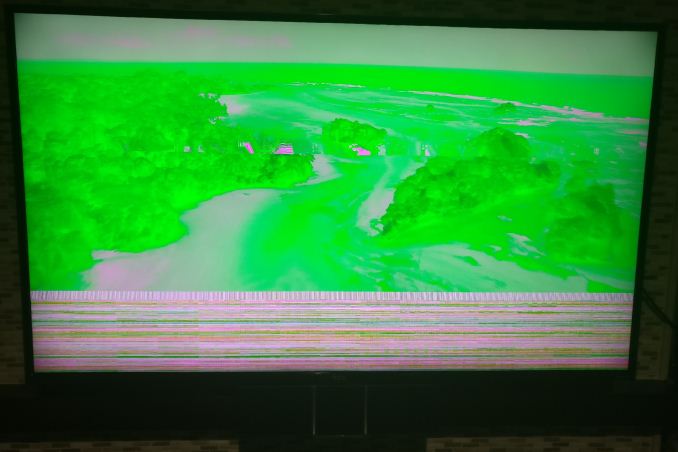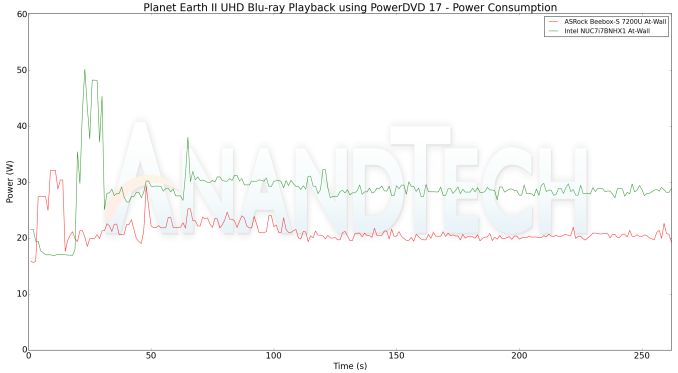A Budget Home Theater & PC Setup: 4K, HDR, UHD Blu-ray, and More
by Ganesh T S on December 26, 2017 8:30 AM ESTUHD Blu-ray Playback in Action
Prior to testing out HDR UHD Blu-ray playback using the TCL 55P607 and the Denon AVR X3400H, we did a trial run with the LG 43UD79-B monitor. The playback was flawless in SDR mode. Emboldened by these results, we moved the hardware to the home theater setup. At that time, the Windows 10 Fall Creators Update was yet to be released. Intel and CyberLink had adopted their own scheme to activate HDR in full screen mode while playing back HDR-enabled titles. Unfortunately, the TCL 55P607 (on firmware version 7.7.0 at that time) did not really like the mode switch.
Corrupted HDR Display with TCL 55P607 Firmware v7.7
I reached out to both Intel and TCL with the above results. While the latter simply washed their hands off the issue, Intel was very responsive. They went to the extent of even sourcing the same display to check at their end. Around the same time, TCL released a firmware update (v8.0.0 4127-30) that resolved the problem.
By the time I was able to upgrade my TV, Windows 10 Fall Creators Update had released and Intel's 4877 driver had also become public. My next testing round had interesting results. The 4877 driver had flawless desktop and streaming HDR, but, playing back the Planet Earth II title resulted in a BSOD, or a PowerDVD crash, or a message indicating that PowerDVD was denied access to the graphics hardware. With an older driver version (4771), I was able to play back the Blu-ray with HDR, but, had no desktop or streaming HDR.
On checking with Intel again, it became evident that the issue was specific to the Planet Earth II title. They provided me with early access to a driver slated for release in January 2018. This driver enabled both the Intel NUC7i7BNHX and the ASRock Beebox-S 7200U to successfully play back the Planet Earth II Blu-ray with HDR, while also performing as per specifications in our other tests detailed in the previous sections.
Note that the Pioneer BDR-211UBK comes with an OEM version of PowerDVD 14 that does support 4K UHD Blu-ray playback.
We tracked the power consumption of the set (PC + Blu-ray drive with the SATA-USB bridge) while playing the first chapter of the first disc in the Blu-ray set (after a full menu loop).
We find that the Beebox-S 7200U is more power efficient for this particular task. The NUC7i7BNHX is much more versatile with its Thunderbolt 3 ports, Optane support, and other bells and whistles. Can those make a difference in a generic HTPC setup? We will address that in our concluding section.













191 Comments
View All Comments
Reflex - Tuesday, January 2, 2018 - link
You are not answering my question:If I play back content that is encoded in DD5.1, 7.1 or Atmos, will your equipment do the proper object placement so that I get a sound effect in the appropriate location?
It is an important detail, if you cannot do that with the material that is available today, your solution is a solution for an audience of one. If it can do that, I am curious how it accomplishes it with what you are describing as essentially a 3.1 setup and with no Dolby or DTS license.
Bullwinkle-J-Moose - Tuesday, January 2, 2018 - link
"what you are describing as essentially a 3.1 setup and with no Dolby or DTS license."-----------------------------------------------------------------------------------------------------------------
The original reference design was 3.0
Moving the Bass speaker to a separate sub cab and calling it a 3.1 system makes zero sense
No Dolby or DTS License is correct
I do not support fake standards forged from a Real Standard
If Dolby and DTS is as good as mine, they should get a License from me
If you wish to play incompatible standards, be my guest
As I have said, I do not support Lesser Quality, incompatible or forged Standards
Dolby Vision is the same in that regard, as I or anyone else can easily create an "Open" Standard that is Visually the Equal of Dolby Vision without need for a Dolby License
Being locked into a proprietary and lesser Standard is "your" choice / not mine!
Reflex - Tuesday, January 2, 2018 - link
Then your setup is good only for you and content you produce, and for the purposes of the article and the discussion thread essentially meaningless. If you can't play back the content that is being produced accurately then it just isn't relevant to the discussion.I'm glad you enjoy your setup, I also enjoy mine.
Bullwinkle-J-Moose - Wednesday, January 3, 2018 - link
"Then your setup is good only for you and content you produce"------------------------------------------------------------------------------------
You are correct
I can produce content for anyone, and they can Lock it down with whichever proprietary standard they want for sale to people like you
My content can be encoded in the standard of the week or whatever "standard" Dolby comes out with next year
Yes, I wanted a system that can master for anyone!
and you want the finished result in a proprietary format of your choice
GOOD FOR YOU!
we are both happy with what we have!
Bullwinkle-J-Moose - Wednesday, January 3, 2018 - link
My Home Audio setups are for creating frontal 2 and 3 channel Audio ImageryI am not interested in surround but I could easily add as many surround channels as the next standard can handle
My focus is on audio production/mixing/mastering/Imaging
yet they are all I need or want for Video / Home Theater as well
All I really want is a great Audio Image in front, so I want what I have and I have what I want!
It's right for ME!
What works for you is also correct
There is no wrong standard here
You can believe in one standard, a hundred standards or none
wiyosaya - Friday, January 5, 2018 - link
I choose C: You are a troll!Aspernari - Tuesday, December 26, 2017 - link
Everything came out of your pocket, except several thousand dollars worth of stuff you recommended because you didn't have to pay for it, so it had no budgetary cost to you.Would you have really bought the $500 receiver instead of a suitable HDMI switch (if you didn't have enough HDMI ports for all your 4k sources) and using ARC or optical out from the TV with your existing receiver?
Your cost/benefit analysis is broken in this article. You keep trying to defend it, but it's not defensible.
ganeshts - Tuesday, December 26, 2017 - link
The $430 receiver was what I wanted in the build. That is what I was ready to spend my budget on.What part of the sentence 'pick and choose from the list' did you not get in the concluding section?
A HDMI switch will not do the job of the AVR.
It is not a matter of defensible or not - I have presented what worked and what didn't, even with the sponsored equipment. I have presented alternatives also. I think $349 for the AVR driving a $700 TV is a very reasonable budget - incidentally, the same amounts that I spent back in 2008 with a Toshiba Regza 46" TV and a Onkyo TX-SR606.
Aspernari - Tuesday, December 26, 2017 - link
Regarding not understanding: I understand just fine. Your choices are poorly considered and presented. I'll restate from elsewhere: You recommend readers buy $200 worth of Bluray-related hardware and deal with BSODs and/or pursue beta drivers, among other issues.Regarding the receiver: I guess you just wanted a new one, since a budget option would have been a TOSLINK cable or other solution to get audio from the TV to your existing receiver, abandoning the HDMI ports on it, and making use of an HDMI switch if you were short on HDMI ports. Total investment of about $40. Sure, you lose some of the functionality of the obsolete receiver (which you could still use fine on 1080p and lower content), but you also save $349 on sale/$430 retail/$464.40ish after tax by not buying a new receiver. Or getting someone to sponsor you.
" I have presented what worked and what didn't, even with the sponsored equipment." - You didn't present anything that I noticed that didn't work with the receiver. You state the inverse actually, "None of the issues encountered in the course of the evaluation presented in this piece could be attributed to the Denon AVR X3400H." - Which may well be true. But you also didn't evaluate the hardware you then recommend people go out and buy anyway, so the entire thing is moot. You're pushing hardware you didn't get your hands on, which just makes this all the more silly.
Imagine publishing a hardware review article, giving something a good "buy" recommendation,but never actually using the product. Oh wait - you just did that.
It's cool that you're going back and making edits based on the response here, but there's really two articles that should have written, crammed into this one:
1) A blog post about stuff you bought and the setup you made, where you can squeeze in your promotional consideration for Denon.
2) The testing you did and the issues you had navigating the current home theater market, focusing on 4k and HDR with HTPCs and high-end settop boxes.
Are you going to actually review the $1000 receiver, or is this article all that they're getting out of it?
edzieba - Tuesday, December 26, 2017 - link
"I guess you just wanted a new one, since a budget option would have been a TOSLINK cable or other solution to get audio from the TV to your existing receiver, "That's... not how things work. At all. Adding an S/PDIF cable is not going to magically allow transport of audio streams that:
a) Are too high bitrate for S/PDIF (which cannot even carry 5.1 LPCM)
b) Were developed decades after the S/PDIF standard
It's as ludicrous and nonsensical a suggestion as installing an IDE cable to allow your SATA motherboard to use m.2 PCIe NVME drives.